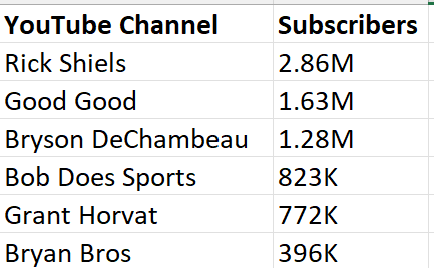Golf Content: The Good, Bad, and Ugly
Admittingly and unsurprisingly, a lot of my content consumption involves golf. Though much of it comes from independent search, I still find myself a victim of the social media algorithms, like so many others. The way algorithms work is that you just don’t see the good stuff, you see it all. Golf content is no different. Having a monumental impact on the industry, I felt it necessary to encapsulate my thoughts on it, hopefully leading to better consumption on your end.
The Good
Visual Connection
One of the most positive aspects of golf content is the ability to showcase natural landscape. With modern photography, videography, and drones, golf courses have never been more visually appealing.
Non-golfers often ask me why I enjoy golf so much. There are many layers to this question, but I typically find the most association from my answer being, “it’s like spending 4 hours in a park.” Sounds pretty awesome to most. People love being outdoors, and golf courses simply provide that, most of the time with some solid scenery.
If you’re scrolling Instagram, keep the golf course reel rolling a little longer to build your algorithm in that favor.
Golf Media
The Golf Media has a bigger voice in the sport than ever before. This is a direct result of increase in access to information and content engagement. There are so many distinct voices covering the game that, because of quality content, speak with significance. Media rows at majors are now filled largely with credible journalists working for golf content companies.
Professional players are also now more connected with the Golf Media. The PGA Tour has protected players’ branding through the years, but recently you’ve seen a shift towards players promoting themselves and giving more opinions. The growing symbiosis and comfortability between players and media is healthy for the sport.
Sure, not all players or journalists are your favorite, but at least there are options to choose from. Decide for yourself who you like and consume their content, because it’s available!
YouTubers/Content Creators
I struggled where to put this as a lot of the content is not necessarily my cup of tea. But when it comes down to it, the Youtubers have captured the attention of the youth. Over the last 5 years, off course junior golfers are up 82% and on course junior golfers are up 40%. Golf is by far the fastest growing junior sport in the US.
When I say YouTubers in this context, I’m speaking about the likes of Rick Shiels, Bryson DeChambeau, Good Good, Grant Horvat, Bob Does Sports, Bryan Bros, etc. Almost all golf content companies are exploring the YouTube space now—but these “content creators” are the needle.
Anything that sparks junior involvement should generally be considered a win. I have some questions about how the product is presented, but also recognize I’m a bit of a purist. The PGA Tour recently announced the Creator Classic the Wednesday before the Tour Championship this year. I’ll be curious about their relationship with content creators going forward—there is obviously a large target audience to be tapped into.
So, as they say, don’t forget to smash that like button and hit subscribe, and let me know what you think in the comments!
The Bad
Swing Content
I’m just going to flat out say it—if you want to get worse at golf, watch these videos. It is bananas to me how many swing "fixes” and videos are floating around on the algorithms. That said, I can relate to the fact of the never-ending addiction of getting better at golf, and that is the crux this content feeds on.
If you want to truly get better at golf, go take a lesson from a PGA Professional and put a plan in place with them. A golfer’s swing is like a fingerprint, it is unique and different from anyone else’s, as is a golfer’s ability to process feels and information. There is no one size fits all.
Most higher handicappers can shave a few shots easily by simple course management and playing more. Apart from the rapid growth in the beginner phase, improvement in golf is incremental baby steps over a long period of time, and everyone plateaus to a degree. Most of these game improvement videos are clickbait for content engagement, and nothing more.
Trackers and Bots
Over the past few years these type of accounts have become an issue. Most player trackers (or TRACKRS) are literally only there for one reason, engagement clicks. They typically produce information in two ways. They first post a lot of unverified information solely for engagement. More concerningly however, is when they post work from legitimate sources for their own interests. Collaboration and promoting additive content is generally encouraged , but stealing and recharacterizing works to boost your own numbers is unoriginal and pathetic.
Also, there are so many paid opinions in the content world. In this context, I am speaking about Bots, specifically LIV ones. These accounts are paid directly through LIV to promote the tour and bash forms of content that, for good reason, criticize the product. You can easily spot one of these phonies on social media. Although it should not be this way, these paid voices have an impact on content. Ignore the Bots.
The Ugly
Original Equipment Manufacturers
At the end of the day, golf content is a business. In pretty much any type of popular content, you will see product promotion. Yes this is standard, but its influence on golf is a colossal one.
My biggest issue with content sponsorships is OEM’s (Titleist, Cobra, Ping, Callaway, Taylormade, etc.) involvement. They are self-interested corporations who do not support what is best for golf. The USGA is instituting a universal rollback, set for 2028 for elite competition and 2030 for recreational golf. We could argue rollback all day, but the evidence is clear that one is needed, especially at the professional level. If you are a recreational player and against rollback, you can directly thank OEM’s and professional golfers for hitting it shorter in 2030. OEM’s whining about bifurcation costs, along with players’ OEM bought opinions, sparked the universal rollback.
My larger point is OEM’s have a financial finger on everything in the golf world, trying to move pieces of the industry in their favor. Most major golf content creators and companies have an OEM sponsorship, constantly pushing their new products. No Laying Up is one of my favorite and most original content companies in the sport, yet their main sponsor is now Titleist (previously Callaway). Their content has suffered in many ways since the Titleist partnership, as the forced advertising does not seem to align with their ethos and feels overdone. On the other hand, Fried Egg Golf has remained adamant about staying independent from OEM’s, which I admire greatly.
Golf content is a huge vehicle for OEM’s and unfortunately when the overall industry has a roughly $90 Billion impact, money matters.
Overconsumption
The golf industry is currently drinking content from a hose—only a matter of time before it is too much. Original quality content is already getting overshadowed by clickbait, making it more and more difficult for independent work to stand out.
Also, overconsumption of social media and content instigates anxieties among many individuals, especially youths. I worry golf is going to be viewed through this content alone and not for what it is, which is unique for everyone. I hope beginners and juniors are still able to go out on a golf course and fall in love with it organically, as opposed to forcing their likeness in hopes to align with some content that they see.
Content for the Curious
📺/🎧- No Laying Up: Justin Thomas Episode, Spotify
🎧- Huberman Labs: Dr. Stuart McGill- Build a Strong, Pain-Proof Back
✍️- No Laying Up: Kevin Van Volkenburg’s GHIN and Tonic
✍️- Perfect Putt: The Growth of Junior Golf





